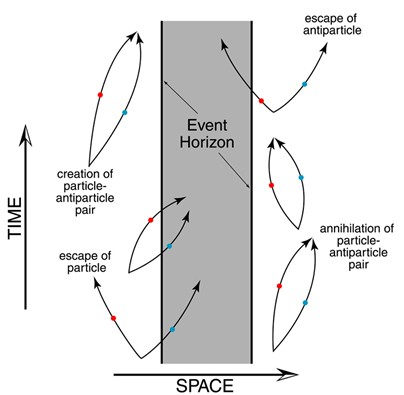Wikipedia - Black Holes - Formation and Evolution
https://en.wikipedia.org/wiki/Black_hole#Formation_and_evolution
Review of the Final States of Stars
Star are born and stars die... just like us. The big massive stars have
but short lives, a few millions of years. Stars like our sun last for a
good 10 billions of years, and the little red stars like Barnard's Star
might last for 100 billion years. How long stars live, is determined by
their mass (which must be at least 80 Jupiter masses to sustain
thermonuclear fusion of hydrogen).
There are four (4) fates for the end of stars depending on their masses
and the masses of their cores:
Red/Brown Dwarf - less than 0.076 Ms <== Main Sequence 0.076-0.8 Ms
Stars less than about 0.6 solar masses, when nuclear fuel is used up,
gravitational collapse shrinks the star, but no more than the gas
temperature-pressure-volume laws of classical physics allow. We have
not found any white dwarf less massive than 0.6 solar masses. Part of
the answer is that the universe may not be old enough for lower mass
stars to have evolved off the main sequence.
White Dwarf - 0.08 and 1.44 Ms <== Main Sequence 0.8-8 Ms
Stars with core masses between 0.08 and 1.44 solar masses are
destined to become white dwarfs. White dwarfs are degenerate matter.
Further collapse is halted by electron degeneracy pressure. See pages
456-459 in your textbook. The vast majority of stars are in this mass
range and are destined to become white dwarfs.
Neutron Star - 1.44 and 2.2 Ms <== Main Sequence 8-30 Ms
Core masses between 1.44 and 2.2 solar masses overcome electron
degeneracy pressure and collapse to form neutron stars, a star that is
essentially one gigantic nucleus. Further collapse is halted by neutron
degeneracy pressure.
Black Hole - 2.3 or more Ms <== Main Sequence > 30 Ms
But for cores with mass of 2.3 or more solar masses, neutron
degeneracy pressure does not stop the collapse and the star becomes a
black hole with zero physical size, but with all the mass. Gravity
really wins!
In each case, gravity eventually wins. But, to what extent is
determined by the mass and the relative pressures of the quantum
mechanical forces, electron and neutron degeneracy pressure.
See: http://www.pbs.org/wgbh/nova/transcripts/2901_gamma.html
Wikipedia - Gravitational Collapse
https://en.wikipedia.org/wiki/Black_hole#Gravitational_collapse
Wikipedia - Uncertainty principle
https://en.wikipedia.org/wiki/Uncertainty_principle
Wikipedia - Quantum fluctuation
https://en.wikipedia.org/wiki/Quantum_fluctuation
Wikipedia - Virtual particle
https://en.wikipedia.org/wiki/Virtual_particle
Wikipedia - Vacuum Energy
https://en.wikipedia.org/wiki/Vacuum_energy
 Wikipedia - Hawking Radiation
https://en.wikipedia.org/wiki/Hawking_radiation
Alan Lightman On Richard Feynman's Amazing Mind, Or How
"Hawking Radiation" Could Well Be "Feynman Radiation" (6+ min)
https://3quarksdaily.com/3quarksdaily/2014/09/alan-lightman-on-richard-feynmans-amazing-mind-or-how-hawking-radiation-could-well-be-feynman-radiat.html
https://player.vimeo.com/video/104516539
What is Hawking Radiation? (1+ min)
https://www.youtube.com/watch?v=DC_IfDxXVbE
Hawking Radiation | PBS Space Time (12+ min)
https://www.youtube.com/watch?v=qPKj0YnKANw
Hawking Radiation Calculator
https://www.vttoth.com/CMS/physics-notes/311-hawking-radiation-calculator
sam.wormley@icloud.com
Wikipedia - Hawking Radiation
https://en.wikipedia.org/wiki/Hawking_radiation
Alan Lightman On Richard Feynman's Amazing Mind, Or How
"Hawking Radiation" Could Well Be "Feynman Radiation" (6+ min)
https://3quarksdaily.com/3quarksdaily/2014/09/alan-lightman-on-richard-feynmans-amazing-mind-or-how-hawking-radiation-could-well-be-feynman-radiat.html
https://player.vimeo.com/video/104516539
What is Hawking Radiation? (1+ min)
https://www.youtube.com/watch?v=DC_IfDxXVbE
Hawking Radiation | PBS Space Time (12+ min)
https://www.youtube.com/watch?v=qPKj0YnKANw
Hawking Radiation Calculator
https://www.vttoth.com/CMS/physics-notes/311-hawking-radiation-calculator
sam.wormley@icloud.com
Wikipedia - Hawking Radiation https://en.wikipedia.org/wiki/Hawking_radiation Alan Lightman On Richard Feynman's Amazing Mind, Or How "Hawking Radiation" Could Well Be "Feynman Radiation" (6+ min) https://3quarksdaily.com/3quarksdaily/2014/09/alan-lightman-on-richard-feynmans-amazing-mind-or-how-hawking-radiation-could-well-be-feynman-radiat.html https://player.vimeo.com/video/104516539 What is Hawking Radiation? (1+ min) https://www.youtube.com/watch?v=DC_IfDxXVbE Hawking Radiation | PBS Space Time (12+ min) https://www.youtube.com/watch?v=qPKj0YnKANw Hawking Radiation Calculator https://www.vttoth.com/CMS/physics-notes/311-hawking-radiation-calculator sam.wormley@icloud.com